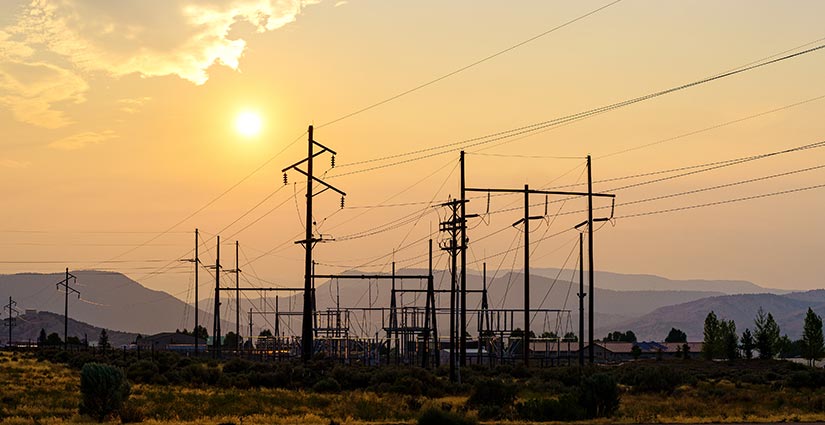Assessing Power System Reliability in a Changing Grid, Environment
NREL's Energy Analysts Use the "Three Rs" Concept To Provide a Fuller Picture of Power System Reliability With Changing Resource Mixes, Grid Conditions

From increasing decarbonization, electrification, and distributed generation, to more frequent extreme weather events from climate change, the electric power system is undergoing immense change. These factors impact how the grid is planned and operated to maintain safe and reliable power.
The North American Electric Reliability Corporation—which is dedicated to monitoring the overall health of the bulk power system and minimizing reliability and security risks—published the 2022 Summer Reliability Assessment. The report identified several areas that are at higher risk this summer due to extreme drought conditions, transmission lines out of service, higher demand, and more. Heightened reliability risks make power system planning even more important.
To frame the issue of reliability, researchers at the National Renewable Energy Laboratory (NREL) use the "three Rs of power system reliability": resource adequacy, operational reliability, and resilience. All three Rs are required for a safe and reliable power system. This concept has guided recent NREL studies on maintaining reliability with a changing grid and environment.
There is no single absolute definition for each of the three Rs, and some aspects overlap. In addition, the metrics used to measure power system reliability are still being developed and are currently an important conversation within the grid planning space. However, the three Rs can inform holistic power system planning and operation to ensure a safe and reliable grid.
"Every region is different and requires its own unique analysis, but the three Rs can help to provide a more comprehensive picture of power system reliability and risk to grid planners, regulators, and policymakers," said Paul Denholm, principal energy analyst at NREL. "The three Rs can also guide the evolution of power system reliability metrics moving forward."
Resource Adequacy: Sufficient Spare Capacity
Resource adequacy is the ability of the power system to supply enough electricity—at the right locations—to keep the lights on, even during extreme weather days or times when load drops. Resource adequacy is typically measured by the probability of an outage over an extended amount of time. When evaluating resource adequacy, NREL broadly considers uncertainty in both supply and demand.
Load uncertainty includes increasing electric demand, stressful load periods, and more. Supply uncertainty includes the occasional but expected common outages in power plants, transmission and distribution lines, and other grid equipment. Supply uncertainty also includes the availability of variable resources like solar and wind, as well as energy storage and demand response, particularly during times of system stress.
An adequate system has enough available resources (e.g., spare capacity and/or flexible load) to replace capacity that fails, is out of service for maintenance, or is unavailable due to fuel constraints. The transmission system is also important to ensuring resource adequacy because it delivers generation from many resources to load sites and enables access to a greater diversity of variable renewable resources and load across neighboring regions.
With more renewables being added to the grid, resource adequacy must increasingly account for the variability of renewable energy supply, role of storage, changes in demand patterns, and impact of transmission outages and interregional coordination.
Operational Reliability: Ability To Respond in Real Time
Operational reliability is the ability of the power system to balance supply and demand in real time by managing variability, ramping constraints, and flexible loads—including immediately following an "event" like a large power plant or transmission line failure. A reliable power system can keep the lights on during these unexpected events with power plants that can rapidly vary output or end users that can reduce their electricity consumption.
One aspect of operational reliability is operating reserves, or available spare capacity that actively responds during an event to help balance power and maintain stable frequency. For example, inertia on the grid allows time for the mechanical systems that control most power plants to detect and respond to a failure.
Grid services like inertia have traditionally been provided by conventional fossil, nuclear, or hydroelectric plants that use spinning synchronous generators. However, wind, solar photovoltaics, and batteries are inverter-based resources, meaning they rely on power electronics, or inverters, to generate grid-compatible electricity.
"As more conventional generators are replaced with inverter-based resources, it's important to understand how they can maintain a safe and stable grid," said Mohit Joshi, NREL grid analyst who supports developing countries in South Asia and Southeast Asia with their long-term power system planning.
Resilience: Ability To Bounce Back
Resilience is not as clearly defined as resource adequacy or operational reliability. The Federal Energy Regulatory Commission defines it as "the ability to withstand and reduce the magnitude and/or duration of disruptive events, which includes the capability to anticipate, absorb, adapt to, and/or rapidly recover from such an event."
Parts of resilience overlap with resource adequacy and operational reliability, but generally it captures how well a system recovers or how quickly power can be restored after an outage. Resilience also includes more extreme events than the typical outages considered with resource adequacy and operational reliability.
"Over the years with increasing renewable generation, electric vehicles, demand response, and other emerging technologies, we have learned that there doesn't have to be a tradeoff between decarbonization and power system reliability," Joshi said. "About a decade ago, there was skepticism in South Asian and Southeast Asian countries whether the power system could operate with wind and solar, but in some grids, we have seen instantaneous contributions of variable generation up to 100%. Moving forward, there will be new technologies and there may be new challenges, but through our research we can find solutions to continue to ensure a low-carbon, safe, and reliable grid."
Learn more about NREL's grid modernization research and energy analysis research.
Last Updated May 28, 2025
